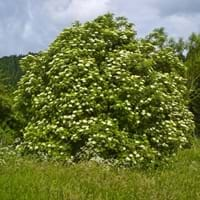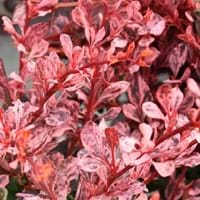Life Span
Perennial
Perennial
Type
Flowering Plants, Fruits, Herbs, Shrubs
Shrub
Origin
Australia, South America
Eastern Asia, Japan
Types
Adams Elderberry, Black Beauty Elderberry, Black Lace Elderberry, Johns Elderberry, Nova Elderberry
Not Available
Number of Varieties
Not Available
Habitat
Farms, Homesteads, Near organic waste disposal
Old fields, stream banks
USDA Hardiness Zone
4-8
4-8
Sunset Zone
2a, 2b, 3a, 3b, 4, 5, 6, 7, 14, 15, 16, 17
A3, 2b, 3a, 3b, 4, 5, 6, 7, 8, 9, 10, 11, 12, 13, 14, 15, 16, 17, 18, 19, 20, 21, 22, 23, 24
Habit
Upright/Erect
Oval or Rounded
Flower Color
White
Yellow, Yellow green
Flower Color Modifier
Not Available
Not Available
Fruit Color
Purple, Red
Red orange
Leaf Color in Spring
Green
Light Green
Leaf Color in Summer
Green
Green
Leaf Color in Fall
Yellow green
Purple, Orange, Burgundy, Crimson
Leaf Color in Winter
Not Available
Not Available
Leaf Shape
Compound
Obovate
Plant Season
Early Spring
Spring, Summer, Fall, Winter
Sunlight
Full Sun, Part sun
Full Sun, Partial Sun
Growth Rate
Medium
Medium
Type of Soil
Loamy, Sandy, Well drained
Clay, Loam, Sand
The pH of Soil
Slightly Acidic
Acidic, Neutral, Alkaline
Soil Drainage
Average
Average
Bloom Time
Early Spring, Spring
Spring, Late Spring
Tolerances
Pollution
Pollution, Drought, Salt, Soil Compaction
Where to Plant?
Ground
Ground, Pot
How to Plant?
Grafting, Seedlings
Seedlings
Plant Maintenance
Medium
Medium
Watering Requirements
Requires regular watering, Use Mulches to help prevent water loss during hot and windy weather
Requires regular watering during dry weather
In Summer
Lots of watering
Lots of watering
In Spring
Moderate
Moderate
In Winter
Average Water
Average Water
Soil pH
Slightly Acidic
Acidic, Neutral, Alkaline
Soil Type
Loamy, Sandy, Well drained
Clay, Loam, Sand
Soil Drainage Capacity
Average
Average
Sun Exposure
Full Sun, Part sun
Full Sun, Partial Sun
Pruning
Cut or pinch the stems, No pruning needed in the early stages, Prune for shortening long shoots, Prune if you want to improve plant shape, Prune in winter, Prune ocassionally, Remove deadheads
Remove damaged leaves, Remove dead branches, Remove dead leaves
Fertilizers
All-Purpose Liquid Fertilizer
All-Purpose Liquid Fertilizer
Pests and Diseases
Canker, Leaf spot, Powdery mildew, Stem spot, Tomato Ringspot Virus
Red blotch, Sunken patches
Plant Tolerance
Drought
Drought
Flowers
Yes
Insignificant
Flower Petal Number
Single
Single
Foliage Texture
Medium
Medium
Foliage Sheen
Matte
Matte
Invasive
Sometimes
Sometimes
Allergy
Diarrhea, Nausea, Vomiting
Not Available
Aesthetic Uses
Not Used For Aesthetic Purpose
Borders
Beauty Benefits
Not Available
Not Available
Environmental Uses
Air purification
Air purification
Medicinal Uses
constipation, Fever, Heart problems, High cholestrol, HIV/AIDS, Nerve pain, swine flu
Anthelmintic, Antibacterial, Antiseptic, Cancer
Part of Plant Used
Flowers, Fruits
Fruits, Leaves
Other Uses
Not Available
Used to make yellow dye
Used As Indoor Plant
No
No
Used As Outdoor Plant
Yes
Yes
Garden Design
Not Available
Edging, Foundation, Hedges, Mixed Border, Rock Garden, Wall
Botanical Name
Sambucus nigra
BERBERIS thunbergii
Common Name
Elderberry
Japanese Barberry
In Hindi
Elderberry
Japanese Barberry
In German
Holunderbeere
Thunberg-Berberitze
In French
Sureau
Berberis thunbergii
In Spanish
Saúco
Berberis thunbergii
In Greek
Elderberry
Japanese Barberry
In Portuguese
Sabugueiro
Japanese Barberry
In Polish
Bez czarny
Berberys Thunberga
In Latin
Elderberry
Japanese Barberry
Phylum
Magnoliophyta
Magnoliophyta
Class
Magnoliopsida
Magnoliopsida
Order
Dipsacales
Ranunculales
Family
Adoxaceae
Berberidaceae
Clade
Angiosperms, Asterids, Eudicots
Angiosperms, Eudicots
Tribe
Not Available
Not Available
Subfamily
Not Available
Not Available
Number of Species
Not Available
Season and Care of Elderberry and Rose Glow Barberry
Season and care of Elderberry and Rose Glow Barberry is important to know. While considering everything about Elderberry and Rose Glow Barberry Care, growing season is an essential factor. Elderberry season is Early Spring and Rose Glow Barberry season is Early Spring. The type of soil for Elderberry is Loamy, Sandy, Well drained and for Rose Glow Barberry is Clay, Loam, Sand while the PH of soil for Elderberry is Slightly Acidic and for Rose Glow Barberry is Acidic, Neutral, Alkaline.
Elderberry and Rose Glow Barberry Physical Information
Elderberry and Rose Glow Barberry physical information is very important for comparison. Elderberry height is 9.00 cm and width 8.00 cm whereas Rose Glow Barberry height is 90.00 cm and width 120.00 cm. The color specification of Elderberry and Rose Glow Barberry are as follows:
Elderberry flower color: White
Elderberry leaf color: Green
Rose Glow Barberry flower color: Yellow and Yellow green
- Rose Glow Barberry leaf color: Light Green
Care of Elderberry and Rose Glow Barberry
Care of Elderberry and Rose Glow Barberry include pruning, fertilizers, watering etc. Elderberry pruning is done Cut or pinch the stems, No pruning needed in the early stages, Prune for shortening long shoots, Prune if you want to improve plant shape, Prune in winter, Prune ocassionally and Remove deadheads and Rose Glow Barberry pruning is done Remove damaged leaves, Remove dead branches and Remove dead leaves. In summer Elderberry needs Lots of watering and in winter, it needs Average Water. Whereas, in summer Rose Glow Barberry needs Lots of watering and in winter, it needs Average Water.





